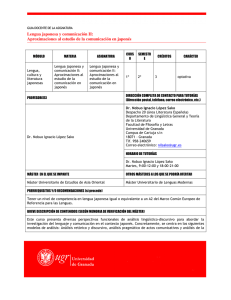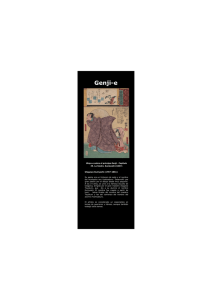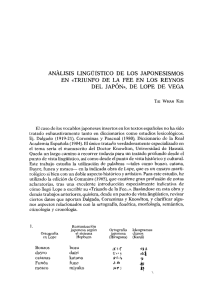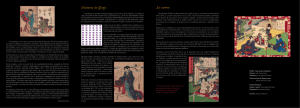El fantasma en el cine japonés de posguerra. De rasgo... Santa Cruz, Antonio Con el estreno de “The Ring” (Hideo...
Anuncio
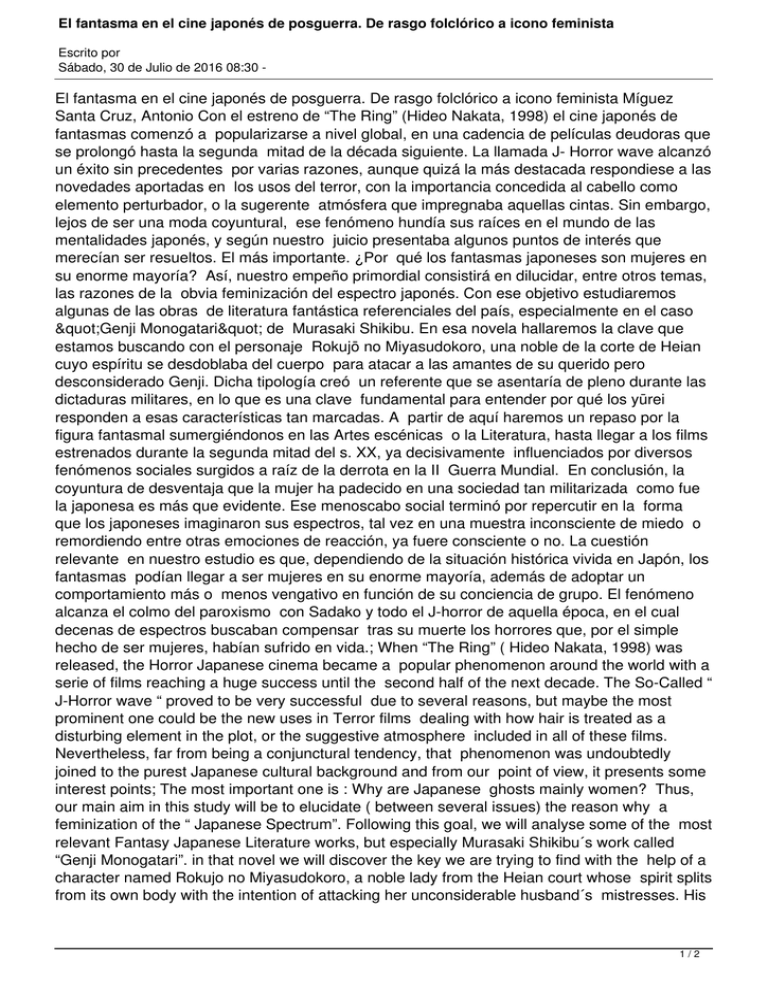
El fantasma en el cine japonés de posguerra. De rasgo folclórico a icono feminista Escrito por Sábado, 30 de Julio de 2016 08:30 - El fantasma en el cine japonés de posguerra. De rasgo folclórico a icono feminista Míguez Santa Cruz, Antonio Con el estreno de “The Ring” (Hideo Nakata, 1998) el cine japonés de fantasmas comenzó a popularizarse a nivel global, en una cadencia de películas deudoras que se prolongó hasta la segunda mitad de la década siguiente. La llamada J- Horror wave alcanzó un éxito sin precedentes por varias razones, aunque quizá la más destacada respondiese a las novedades aportadas en los usos del terror, con la importancia concedida al cabello como elemento perturbador, o la sugerente atmósfera que impregnaba aquellas cintas. Sin embargo, lejos de ser una moda coyuntural, ese fenómeno hundía sus raíces en el mundo de las mentalidades japonés, y según nuestro juicio presentaba algunos puntos de interés que merecían ser resueltos. El más importante. ¿Por qué los fantasmas japoneses son mujeres en su enorme mayoría? Así, nuestro empeño primordial consistirá en dilucidar, entre otros temas, las razones de la obvia feminización del espectro japonés. Con ese objetivo estudiaremos algunas de las obras de literatura fantástica referenciales del país, especialmente en el caso "Genji Monogatari" de Murasaki Shikibu. En esa novela hallaremos la clave que estamos buscando con el personaje Rokujō no Miyasudokoro, una noble de la corte de Heian cuyo espíritu se desdoblaba del cuerpo para atacar a las amantes de su querido pero desconsiderado Genji. Dicha tipología creó un referente que se asentaría de pleno durante las dictaduras militares, en lo que es una clave fundamental para entender por qué los yūrei responden a esas características tan marcadas. A partir de aquí haremos un repaso por la figura fantasmal sumergiéndonos en las Artes escénicas o la Literatura, hasta llegar a los films estrenados durante la segunda mitad del s. XX, ya decisivamente influenciados por diversos fenómenos sociales surgidos a raíz de la derrota en la II Guerra Mundial. En conclusión, la coyuntura de desventaja que la mujer ha padecido en una sociedad tan militarizada como fue la japonesa es más que evidente. Ese menoscabo social terminó por repercutir en la forma que los japoneses imaginaron sus espectros, tal vez en una muestra inconsciente de miedo o remordiendo entre otras emociones de reacción, ya fuere consciente o no. La cuestión relevante en nuestro estudio es que, dependiendo de la situación histórica vivida en Japón, los fantasmas podían llegar a ser mujeres en su enorme mayoría, además de adoptar un comportamiento más o menos vengativo en función de su conciencia de grupo. El fenómeno alcanza el colmo del paroxismo con Sadako y todo el J-horror de aquella época, en el cual decenas de espectros buscaban compensar tras su muerte los horrores que, por el simple hecho de ser mujeres, habían sufrido en vida.; When “The Ring” ( Hideo Nakata, 1998) was released, the Horror Japanese cinema became a popular phenomenon around the world with a serie of films reaching a huge success until the second half of the next decade. The So-Called “ J-Horror wave “ proved to be very successful due to several reasons, but maybe the most prominent one could be the new uses in Terror films dealing with how hair is treated as a disturbing element in the plot, or the suggestive atmosphere included in all of these films. Nevertheless, far from being a conjunctural tendency, that phenomenon was undoubtedly joined to the purest Japanese cultural background and from our point of view, it presents some interest points; The most important one is : Why are Japanese ghosts mainly women? Thus, our main aim in this study will be to elucidate ( between several issues) the reason why a feminization of the “ Japanese Spectrum”. Following this goal, we will analyse some of the most relevant Fantasy Japanese Literature works, but especially Murasaki Shikibu´s work called “Genji Monogatari”. in that novel we will discover the key we are trying to find with the help of a character named Rokujo no Miyasudokoro, a noble lady from the Heian court whose spirit splits from its own body with the intention of attacking her unconsiderable husband´s mistresses. His 1/2 El fantasma en el cine japonés de posguerra. De rasgo folclórico a icono feminista Escrito por Sábado, 30 de Julio de 2016 08:30 - name ( the husband) is called Genji. This typology created a new reference figure properly established during the military dictatorships in the country, and this fact was also essential for the understanding of the Yurei characteristics or behaviour. From now on, we will revise the Ghost presence getting into Japanese Literature as well as Performing arts until the second half of the 20 th century film releases which are deeply influenced by several social phenomena emerged after the Japanese Second World War defeat. It is quite evident that Japanese women suffered a disadvantaged situation if we compare them with men due to a highly militarized society in those years. That same social impairment ended up affecting the way in which Japanese population could (consciously or not) imagine their Ghosts. The outstanding topic discussed in our Thesis is that, depending on the historical situation lived in Japan, Ghosts were mainly women and they might also assume a more or less vengeful role according to their group unity. The phenomenon reached its highest level of paroxysm with authors such as Sadako and the “J- Horror” movies at that time in which hundred of spectra tried to balance the pain suffered during their lives after their death, just for being women. Lee el articulo completo 2/2
